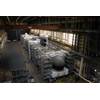U.S. to Cut Nuclear Launchers under Russia Treaty
The United States will scale back its nuclear bombers, submarine launchers and ballistic missiles in the first cuts to its leftover cold war nuclear arsenal since ratifying a landmark treaty with Russia in 2011, officials said on Tuesday.
Under the treaty, known as New Start, the U.S. military will disable four missile launch tubes on each of the 14 U.S. nuclear submarines, convert 30 B-52 nuclear bombers to conventional use and empty 50 intercontinental ballistic missile silos, senior administration officials said.
The Pentagon, however, will not retire a missile squadron as some lawmakers had expected.
The treaty caps deployed strategic nuclear warheads, those meant to travel long distances, in Russia and the United States at 1,550 each by 2018, down from the previous ceiling of 2,200. It also resumes inspections of U.S. and Russian nuclear-weapons facilities that ended in 2009 when the original Start lapsed.
The New START treaty, agreed in 2010 and ratified in 2011, also calls for each side to reduce its total number of nuclear weapons delivery systems to no more than 800, with only 700 deployed at any given time.
The United States has 886 deployed and non-deployed delivery systems, officials said, comprising 454 Minuteman III intercontinental ballistic missiles, 336 Trident II submarine-launched ballistic missiles and 96 B-2 and B-52 bombers.
To eliminate the 86 excess launchers and reach the total 800 deployed and non-deployed systems, the Pentagon will alter four launch tubes on each of the 14 Trident submarines to render them unusable, eliminating 56 delivery systems. It also will convert 30 B-52 bombers to conventional use, the officials said.
To ensure the number of total deployed launchers is no more than 700, the Defense Department will have two Trident ballistic missile submarines in overhaul at any given time, which would mean their 40 missiles no longer be deployed.
It would maintain six nuclear bombers in non-deployed status, including three test aircraft.
The Air Force has four missile silos for testing that would be considered non-deployed, the officials said. In addition it would remove the missiles from 50 launchers at the three U.S. nuclear bases: F.E. Warren in southeast Wyoming, Minot in North Dakota and Malmstrom in Montana, the officials said.
While some lawmakers had voiced concern an entire ballistic missile squadron would be eliminated under the treaty, officials said spreading the cuts over three bases made that unnecessary.
Critics said the Pentagon could make deeper cuts.
"The administration's plan for adjusting the force to meet New START goals is modest in the extreme and still leaves the U.S. with far more strategic nuclear weapons than the president and the Pentagon say they need for deterrence purposes," said Daryl Kimball, executive director of the Arms Control Association, an antiproliferation group.
The cost of implementing the changes is expected to be about $300 million, with most of the expense being for inactivating the nuclear submarine missile tubes.
U.S. weapons makers are keeping a close eye on plans to modernize the platforms that carry nuclear arms, an effort analysts say will cost $355 billion in coming decades.
Boeing Co has teamed with Lockheed Martin Corp to compete against Northrop Grumman Corp to build a new bomber to carry nuclear weapons. General Dynamics Corp is leading early design work on a new submarine to replace the Ohio-class submarines that carry nuclear weapons.
(By David Alexander; Additional reporting by Andrea Shalal; Editing by Jason Szep, Andrew Hay, Paul Simao and Eric Walsh)














 December 2025
December 2025



